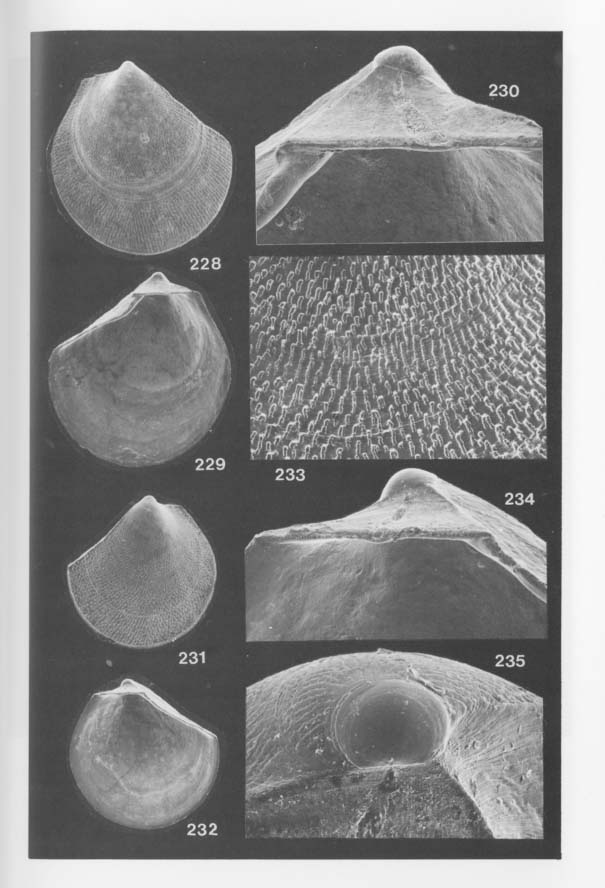Systematic Description
Divarilima elegans sp. nov.
Divarilima elegans sp. nov. |
  |
1992. Divarilima aff. iwaotakii, Kase and Hayami, Jour. Moll, Studies, vol.58, p.448, listed.
Type and material.—Holotype: RM19489a, a right valve, from the bottom sediments of "Shodokutsu" of Ie Islet, Okinawa, Paratypes: RM19489 (dead) from the type locality. No living specimens have been found.
Diagnosis.—Small-sized, semicircular species of Divarilima, characterized by Plagiostoma-like outline, strong shell convexity, relatively short and excavated anterior margin, numerous punctations arranged in irregularly divaricate or zigzag rows, and narrowly elongate prosoclinal ligament pit.
Description.—Shell small, rarely exceeding 3.5 mm in length and height, very thin, translucent, remarkably opisthocline, semicircular, strongly convex. Dorsal margin relatively short, occupying about two-fifths of shell length, bearing numerous denticles of provinculum. Anterior auricle is very small; posterior one is moderate in size. Anterior umbonal ridge sharp, very opisthoclinal, overhanging wide and deeply excavated "lunule". Anterior margin relatively short, concave in dorsal part. Ventral and posterior margins broadly arcuate. Surface of dissoconch wholly marked with delicate punctations which are quincuncially arranged and apparently form numerous divaricate or zigzag rows. Cardinal area very wide, triangular, divided into subequal areas by ligament pit which is unusually narrow, curved and remarkably prosoclinal, Umbo located anteriorly from mid-point of dorsal margin. Pd I large, D-shaped, ranging 200-226 µm in maximum diameter; Pd II absent entirely.
Remarks.—The quincuncially arranged punctations on the surface (Figure 233), which look like divaricate or zigzag striae to the naked eye, indicate that the present species belongs to Divarilima. Actually, it closely resembles Acesta iwaotakii Habe, 1961a, from lower sublittoral substrata at several localities of south-central Japan, which was referred to Divarilima by Habe (1977a). Though the original line-drawing illustration of A. iwaotakii may look dissimilar, the actual outline and surface sculpture of that species are almost identical with those of the present species. However, the shell-size is smaller by half (the length and height exceed 6 mm in the holotype and many other specimens of D. iwaotakii), the ligament pit more prosoclinal, the "lunule" somewhat wider and the Pd I distinctly larger in the present species.
The anterior umbonal ridge, as defined by Cox (1943: 156), forms an obtuse angle of about 145° with the hinge axis in the present species. This value may be larger than that of D. iwaotakii and probably most other extant limids. The present species may also be comparable with Lima sydneyensis Hedley, 1904, from New South Wales, the type species of Divarilima, a specimen of which was recently well illustrated by Lamprell and Whitehead (1992). The shell of the present species, however, is much smaller and broader, and the ligament pit more prosoclinal. Lima albicoma Dall, 1886 (its illustration first appeared in Dall (1902)), from Florida and Barbados, which shares hemicircular outline and delicate divaricate striae with the present species, is certainly another congener, though the shell size of the Caribbean species is also more than twice as large.
In the shell shape, particularly the excavated anterior margin, strong and very opisthoclinal anterior umbonal ridge and wide triangular cardinal area, Divarilima together with Acesta in deep waters seems to represent a primitive group of the Limidae, which includes Plagiostoma and some other genera in the Mesozoic. Divarilima seems to be represented by a few vicariate species separately distributed in the western Pacific and Caribbean Sea, and these extant species were probably derived from a common ancestral stock before the mid-Tertiary closure of the Tethyan Ocean.
Distribution.— Empty valves occur very abundantly in the bottom sediments of a sublittoral cave of Ie Islet. No specimen has been found in the caves of Shimoji and Irabu Islets.